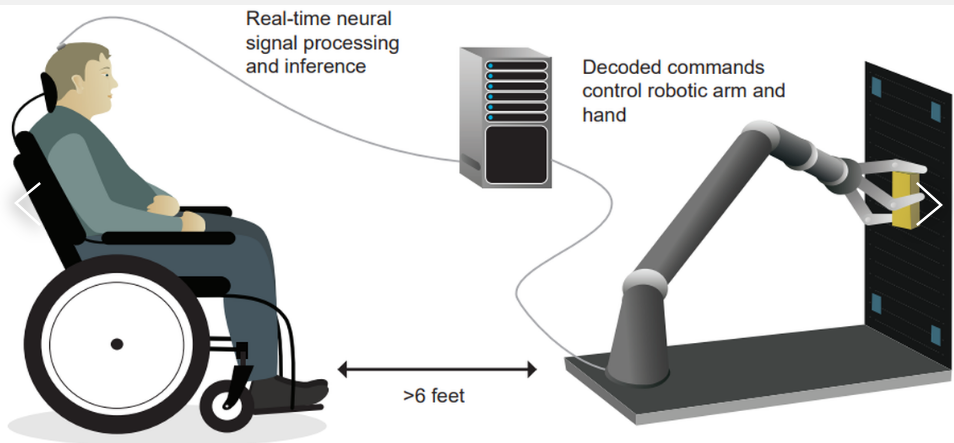Brain-Computer Interface (BCI) Breakthrough

- 01 May 2025
In News:
In a pioneering advancement in neurotechnology and assistive healthcare, scientists at the University of California, San Francisco (UCSF)have developed a stable Brain-Computer Interface (BCI) system that enables a paralysed individual to control a robotic arm using only brain signals. This innovation holds transformative potential for people with paralysis, significantly enhancing autonomy and quality of life.
What is Brain-Computer Interface (BCI)?
A Brain-Computer Interface (BCI) is a neurotechnological system that establishes direct communication between the brain and external devices, bypassing damaged neural pathways. It decodes neural signals related to intended movements and translates them into actionable commands to control robotic limbs, computers, or speech systems.
Key Technological Achievements
- Long-Term Stability: The developed BCI system allowed continuous and accurate control of a robotic arm for over 7 months with minimal recalibration, overcoming a major limitation of earlier BCI systems.
- Sensor Implantation: Tiny electrodes were implanted in the motor cortex, the region of the brain that governs movement.
- AI-Powered Signal Decoding: The system used machine learning algorithms to decode brain activity and adapt to daily shifts in neural signals, ensuring consistent performance.
- Virtual to Real Transition: The participant underwent virtual training with a robotic arm before controlling a real-world robotic limb, aiding in precision and neural calibration.
Functionality Demonstrated
The paralysed participant, who had lost all movement and speech abilities due to a stroke, could:
- Pick up and rotate blocks
- Open cabinets
- Retrieve and position a cup under a water dispenser
These basic actions, enabled purely by imagined movement, highlight the immense real-world utility of the BCI system.
Scientific Insights
- High-Dimensional Neural Mapping: Although neural signals shifted slightly each day, their overall structure remained consistent. This allowed researchers to create a dynamic AI framework that predicted and compensated for signal changes.
- No Direct Brain Stimulation: The system only read signals and did not send any electrical impulses to the brain.
- End-to-End Signal Processing Pipeline: From capturing brain signals to executing robotic arm movement, a seamless pipeline was established for fluid, real-time motion.
Broader Applications
The implications of this BCI research go beyond limb movement:
- Restoration of Speech: In cases of ALS (Amyotrophic Lateral Sclerosis) and brainstem stroke, BCIs can decode intended speech from neural activity and render it as text, synthesized voice, or avatar speech.
- Faster Communication: A recent trial showed an ALS patient using BCI technology to communicate at 62 words per minute, nearly 3.4 times faster than earlier systems.
Future Prospects & Challenges
- Scalability: More work is needed to generalize this system for diverse forms of paralysis.
- Complex Environments: Future BCIs must function in real-world environments filled with distractions, like grocery stores or public spaces.
- Ethical and Regulatory Oversight: Given the invasive nature of electrode implantation, ethical considerations around consent, privacy, and long-term effects must be addressed.
